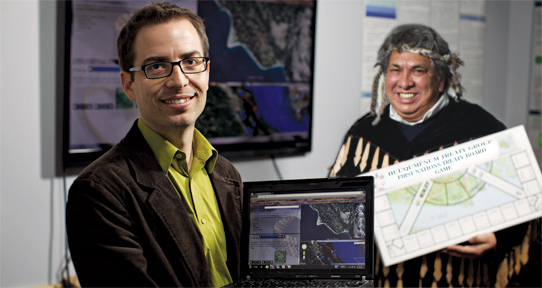A virtual journey through the Coast Salish cultural landscape

What’s at stake in treaty negotiations? What is the cultural significance of the land? As one BC First Nations group has learned, the complex language of land claims can be a key obstacle to making well-informed decisions about the treaty process.
Now, thanks to researchers and students in the University of Victoria’s anthropology and computer science departments, First Nations communities can learn about the treaty process and their traditional territories in a fun way—by playing a video game.
Through traditional stories and place names spoken by community elders, players learn about the cultural significance of the land for the Hul’qumi’num Treaty Group (HTG)—a BC-based First Nations organization in Ladysmith.
The Hul’qumi’num people are made up of six First Nations—Cowichan, Chemainus, Penelakut, Lyackson, Halalt and Lake Cowichan.
More than 1,000 Hul’qumi’num archaeological heritage sites have been recorded on southeastern Vancouver Island and the Gulf Islands. Although few ancestral villages have been dated, several go back more than 5,000 years—contemporary to the Old Kingdom of Egypt.
Ongoing research in collaboration with the Hul’qumi’num Treaty Group has documented over 700 place names in the Hul’qumi’num’ language. The stories, meanings and experiences of these named places continue to be a vital part of Coast Salish cultural life.
The Hul’qumi’num Treaty Group has been negotiating land claims with Canada and BC since 1993. About 335,000 hectares of land on Vancouver Island and the Gulf Islands are being discussed.
The video game is a collaborative project designed by UVic faculty and grad students. The HTG approached UVic anthropologist Brian Thom about converting a popular board game they had developed to teach members about the treaty process into a video game.
Thom teamed up with UVic computer scientist Yvonne Coady to take the project to their students. “We designed a graduate-level course that had students in both our departments working together on a game that would address the needs of the First Nations group in a culturally respectful and informed way,” says Thom.
The students consulted First Nations elders to develop the game storyline, which takes players on a virtual journey through the Coast Salish cultural landscape of southeast Vancouver Island and the Gulf Islands. Players “travel” to culturally significant places, experiencing traditional knowledge through video, audio, detailed maps and photographs.
At each of these places, players are asked questions that develop their knowledge of critical issues and terms related to the treaty process. When all six levels of the treaty process are completed, players can download a “final agreement” certificate to celebrate their achievement.
The motivational hook for players is the unique experience the game provides for learning the Coast Salish cultural landscape.
They hear about places like Kwa’mutsun (Quamichan), Puneluxutth’ (Penelakut), and Stz’uminus (Chemainus), which are centres of community life today. They see and hear elders such as Joey Caro talk about place names and tell the stories behind them.
“Everyone is on computers these days,” says Caro, communications director at the HTG and creator of the original board game. “A video game is a fun way to teach our community about the treaty process and provide information about the land, uses of the land, and historic place names associated with the land.”
Caro wants the video game to be accessible to everyone in the First Nations community and beyond. And the developers hope that other communities will embrace the idea when they demo the video game to the Assembly of First Nations and First Nations Summit.
“At a time when First Nations and the general public are reflecting critically on the treaty process,” says Thom, “it makes sense to look for innovative ways to educate everyone concerned about what’s at stake—and make it interesting in the process.”
The video game is available online at web.uvic.ca/~htg.
